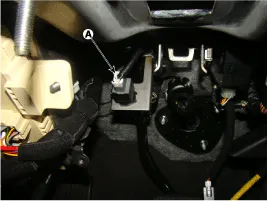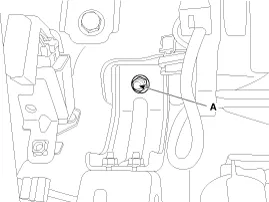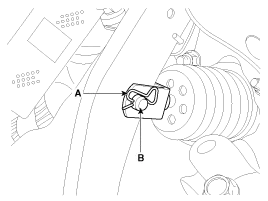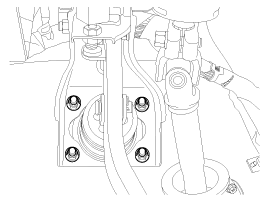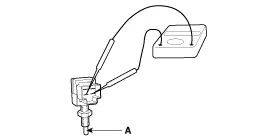Hyundai Genesis (DH): Brake System / Brake Pedal Repair procedures
Hyundai Genesis (DH) 2013-2016 Service Manual / Brake System / Brake System / Brake Pedal Repair procedures
| Removal |
| 1. |
Turn ignition switch OFF and disconnect the negative (-) battery cable. |
| 2. |
Remove the crash pad lower panel.
(Refer to Body - "Crash Pad Lower Panel") |
| 3. |
Disconnect the stop lamp switch connector (A).
|
| 4. |
Remove the brake pedal member mounting nut (A).
|
| 5. |
Remove the snap pin (A) and clevis pin (B).
|
| 6. |
Remove the brake pedal member assembly mounting nuts and then remove the brake pedal assembly.
|
| Inspection |
| 1. |
Check the bushing for wear. |
| 2. |
Check the brake pedal for bending or twisting. |
| 3. |
Check the brake pedal return spring for damage. |
| 4. |
Check the stop lamp switch.
|
| Installation |
| 1. |
To install, reverse the removal procedure. |
| 2. |
Adjust the brake pedal height and free play. |
| 3. |
Check the brake pedal operation after installing the brake pedal. |
Components 1. Brake pedal member assembly2. Stop lamp switch3. Clevis pin4. Snap pin5. Brake pedal stopper6. Return spring7. Bolt
Components 1. Caliper body2. Guide pin3. Locking pin4. Brake pad5. Cover plate 6. Pad spring7. Bleed screw
Other information:
Hyundai Genesis (DH) 2013-2016 Service Manual: PGS Unit (Back & Blinde Unit) Repair procedures
Removal 1. Disconnect the negative (-) battery terminal. 2. Remove the glove box housing (A). (Refer to Body - "Glove Box") 3. Remove the PGS unit (A) after loosening the nuts. Installation 1. Install the PGS unit. 2. Install the glove box housing.
Hyundai Genesis (DH) 2013-2016 Service Manual: Blower Unit Repair procedures
R
Categories
- Manuals Home
- Hyundai Genesis Owners Manual
- Hyundai Genesis Service Manual
- Steering System
- Engine Coolant Temperature Sensor (ECTS) Repair procedures
- 4 Wheel Drive (AWD) System
- New on site
- Most important about car
Copyright В© 2025 www.hgenesisdh.com - 0.0276

